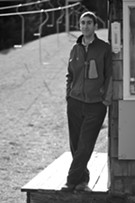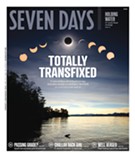Published September 24, 2008 at 5:41 a.m.
You don't need to be creative to break a Guinness world record. Countless record holders have put thought into inventing unlikely categories, and to beat them you just have to do them one better.
Example: If you're into snakes, hold 13 live poisonous rattlesnakes suspended from your mouth, and you'll break Jackie "the Texas Snakeman" Bibby's record. Or think you're a decent tumbler? Just somersault the route of Paul Revere's 12-mile ride ("The British are coming!") in under 10 and a half hours, and Ashrita Furman's record will be history. (Furman probably wouldn't even mind, because he holds 113 other titles, including pushing an orange with his nose for a mile in the shortest time [24 minutes, 36 seconds]; making three complete rotations with a hula hoop 14 feet in diameter; and skipping through an entire marathon in five hours and 55 minutes.)
Two reasonable questions flow from these facts: "Really?" and "Why?" The answer to the first one is easy, since Guinness has strict documentation and witness requirements for issuing a coveted world-record certificate. Yes, people have done these things. The second question is a little more philosophical; its answer is part history lesson and part psychological study. And it's the basis of Larry Olmsted's first book, Getting Into Guinness, published on September 16.
Olmsted, 42, is a Hartland-based travel writer who focuses on participant sports such as golf, skiing and biking. He's the rare specimen of scribe who gets paid, in essence, to go on vacation. In fact, he's got a weekly column in USA Today called "Life on Vacation," which is about second-home destinations. He's written for Playboy, Outside's Go and Men's Health, and is a contributing editor at Cigar Aficionado, U.S. Airways and Elite Traveler.
With more space than he's ever been allotted in the glossies, Olmsted digs deep into the Guinness phenomenon, recounting the history of the publication, interviewing some of the most famous people in its pantheon and, in a particularly gruesome chapter, telling of record attempts gone wrong. The secondary purpose of the book, he says, was to share his own stories of breaking world records, which he does in a straightforward, humorous and self-deprecating tone.
On a recent morning, after completing a 15-mile run, Olmsted sat down for a cup of coffee to explain how his writer's interest strayed from lavish bike tours through Tuscany to the oddball world of Guinness world records.
He was on assignment in Ireland in the spring of 2003, he recalls, when he read a story in the local newspaper about the upcoming 50th anniversary of The Guinness Book of World Records (streamlined in 2000 to Guinness World Records). Like most people, Olmsted hadn't looked at a copy of the book since he was a teenager and didn't know much about it, but he found it curious that people regularly performed incredible and dangerous feats to appear in its pages. When he read that it was the bestselling copyrighted book in history, with more than 100 million copies printed in 37 languages, he filed that away in his freelance-writer memory bank of story ideas. "I'm always, as a journalist," Olmsted says, "looking for that story: the thing that people recognize but don't understand."
Then he promptly forgot it. But a few months later, Olmsted had breakfast with the managing editor of Golf Magazine, who told him that the venerable authority was under attack from startup magazines - Balls and Golf Punk, for example - that eschewed and mocked the "plaid-pants-wearing" image of golf. The managing editor wanted to run something offbeat and edgy. "I was just sitting there," Olmsted remembers, "and something clicked." He thought of the story he'd read in Ireland, spouted a few facts and figures, and then suggested he try to break a golf-related world record and write about it. The editor licked his lips and sent Olmsted off with a tentative yes.
Thumbing through the golf section of Guinness World Records taught Olmsted that he couldn't break a skill-based record - those were the province of pros like Tiger Woods and Annika Sorenstam. He needed something that combined unusual stamina and logistics; something a tad wacky. Then he saw a record called "Greatest Distance Traveled Between Two Rounds of Golf Played on the Same Day." "That I can do," he recalls thinking.
The record at the time was held by a gentleman who played a round of golf in London and then one in California - 5954 miles away. Olmsted bested him by taking advantage of the International Date Line, playing a round in Sydney, Australia, and then another outside Los Angeles, for a total distance of 7496 miles. With that, he made it into the May 2004 issue of Golf Magazine - and the gold-covered 50th-anniversary edition of Guinness World Records.
Back on the home front, Olmsted had his certificate safely ensconced in an expensive, archival-quality frame, and he was an immediate hit at dinner parties. "People of every age and background have an insatiable thirst for all things Guinness," he writes, "and I've learned that once the topic of world records comes up, the genie is out of the bottle: Like it or not, I become the center of undivided attention."
More than his experience of breaking a record, it was the hero's welcome Olmsted received that encouraged him to write his own book on the topic. He wanted to know how Guinness World Records - originally published in 1955 by a subsidiary of the brewing company Arthur Guinness & Sons - went from being a serious reference book with almost no pictures to a quirky "public forum" that 10,000 people try to enter every year.
Olmsted describes Guinness World Records as the precursor to reality TV, Facebook and MySpace: It gave the throngs toiling in unsung anonymity a route to their 15 minutes of fame. "It used to be virtually impossible," he says, "for the average person to attain any level of exposure." Fame is cheaper today, but that doesn't stop people from applying to Guinness to set the record for falling down the most flights of stairs. (That category was rejected as too dangerous.) The allure remains.
Norris McWhirter, the book's creator, understood the draw better than anyone; he once said that record breakers "are desperate to be the person who did something, not just a person." And the record holders themselves don't pretend any different. Jackie "the Texas Snakeman" Bibby, for example, told Olmsted in an interview: "I like the attention. I'm an egomaniac with an inferiority complex. I love being noticed and recognized."
Bibby may be an egomaniac, but Olmsted offers another possible explanation: Neurological studies have shown that fame provides a rush similar to hitting the jackpot in a casino, eating chocolate, or having sex. Olmsted says he felt that thrill during parties where he was the center of attention, and he attributes his second record-breaking feat - world's longest poker session, at 72 hours - to the irrational but very real sense of well-being the fame afforded him. "On the one hand," he explains, "I knew intellectually that it didn't make any sense, but on the other hand it feels good, like winning the Boston Marathon."
Fame's siren song also calls to whole towns and cities, even in down-to-earth Vermont. In August, for example, Rutland broke the record for the largest game of Twister, on a board measuring 102 by 39 feet. In October 2006, Manchester set a record for the most jack-o'-lanterns carved simultaneously in one place (300). Two records were broken just last week in the Green Mountain State: The Shelburne Museum organized the loudest collective dog bark, shattering the former record of 110 decibels set in 2003 in La Crosse, Wisconsin; and an enrichment center in Woodstock called Zack's Place created the longest moving chain of wheelchairs (106).
Given that so many people and places are eager to be recognized in Guinness World Records, and that they secure the book and its holding company a tidy income - it's an annual New York Times bestseller - one might think getting in would involve a transparent, user-friendly process. But what most surprised Olmsted during his research was how difficult it was for a person to apply for a world-record attempt. "What I discovered," he reveals, "is that they are really quite pompous and rigid. They make it almost intentionally difficult for record breakers, and yet these people are not getting paid."
It takes a few months, Olmsted says, to get a response to an initial record inquiry, and then another couple of months to get the official rules and guidelines - if your attempt receives the green light.
Getting Into Guinness includes a section with tips on the most efficient way to break a record. But Olmsted can't use his expertise to break another himself - Guinness has effectively blacklisted him since his book was published, he says. Never mind: Olmsted has found a way around the record keepers that involves renouncing personal glory in favor of the collective version. He plans to attend the world's largest pub crawl next summer, in Maryborough, Australia.
Info:
Getting Into Guinness by Larry Olmsted. HarperCollins, 320 pages. $24.95.
More By This Author
Speaking of...
-

Video: Musicians Jeremiah and Annemieke McLane Move into their New Home
Mar 24, 2022 -

Creating Art That Celebrates the Culture and Climate of Places Around the Globe
Jun 29, 2021 -

Video: Storyteller Ferene Paris Meyer Inspires a Juneteenth Mural
Jun 17, 2021 -

Arts and Culture Nonprofits to Receive $5 Million in State Relief Grants
Jul 7, 2020 -

18 Elm in Waterbury Creates Community at the Table
Jul 9, 2019 - More »
Comments
Comments are closed.
From 2014-2020, Seven Days allowed readers to comment on all stories posted on our website. While we've appreciated the suggestions and insights, right now Seven Days is prioritizing our core mission — producing high-quality, responsible local journalism — over moderating online debates between readers.
To criticize, correct or praise our reporting, please send us a letter to the editor or send us a tip. We’ll check it out and report the results.
Online comments may return when we have better tech tools for managing them. Thanks for reading.














































